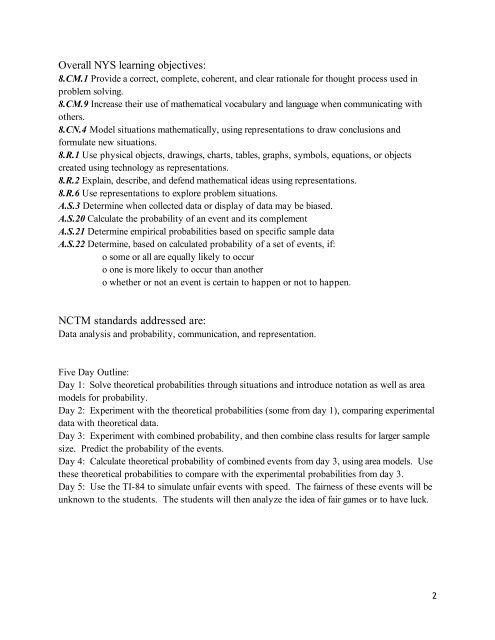A Week of Theoretical and Experimental Probability By: Jeff Thorp
A Week of Theoretical and Experimental Probability By: Jeff Thorp
A Week of Theoretical and Experimental Probability By: Jeff Thorp
Create successful ePaper yourself
Turn your PDF publications into a flip-book with our unique Google optimized e-Paper software.
Overall NYS learning objectives:<br />
8.CM.1 Provide a correct, complete, coherent, <strong>and</strong> clear rationale for thought process used in<br />
problem solving.<br />
8.CM.9 Increase their use <strong>of</strong> mathematical vocabulary <strong>and</strong> language when communicating with<br />
others.<br />
8.CN.4 Model situations mathematically, using representations to draw conclusions <strong>and</strong><br />
formulate new situations.<br />
8.R.1 Use physical objects, drawings, charts, tables, graphs, symbols, equations, or objects<br />
created using technology as representations.<br />
8.R.2 Explain, describe, <strong>and</strong> defend mathematical ideas using representations.<br />
8.R.6 Use representations to explore problem situations.<br />
A.S.3 Determine when collected data or display <strong>of</strong> data may be biased.<br />
A.S.20 Calculate the probability <strong>of</strong> an event <strong>and</strong> its complement<br />
A.S.21 Determine empirical probabilities based on specific sample data<br />
A.S.22 Determine, based on calculated probability <strong>of</strong> a set <strong>of</strong> events, if:<br />
o some or all are equally likely to occur<br />
o one is more likely to occur than another<br />
o whether or not an event is certain to happen or not to happen.<br />
NCTM st<strong>and</strong>ards addressed are:<br />
Data analysis <strong>and</strong> probability, communication, <strong>and</strong> representation.<br />
Five Day Outline:<br />
Day 1: Solve theoretical probabilities through situations <strong>and</strong> introduce notation as well as area<br />
models for probability.<br />
Day 2: Experiment with the theoretical probabilities (some from day 1), comparing experimental<br />
data with theoretical data.<br />
Day 3: Experiment with combined probability, <strong>and</strong> then combine class results for larger sample<br />
size. Predict the probability <strong>of</strong> the events.<br />
Day 4: Calculate theoretical probability <strong>of</strong> combined events from day 3, using area models. Use<br />
these theoretical probabilities to compare with the experimental probabilities from day 3.<br />
Day 5: Use the TI-84 to simulate unfair events with speed. The fairness <strong>of</strong> these events will be<br />
unknown to the students. The students will then analyze the idea <strong>of</strong> fair games or to have luck.<br />
2

















